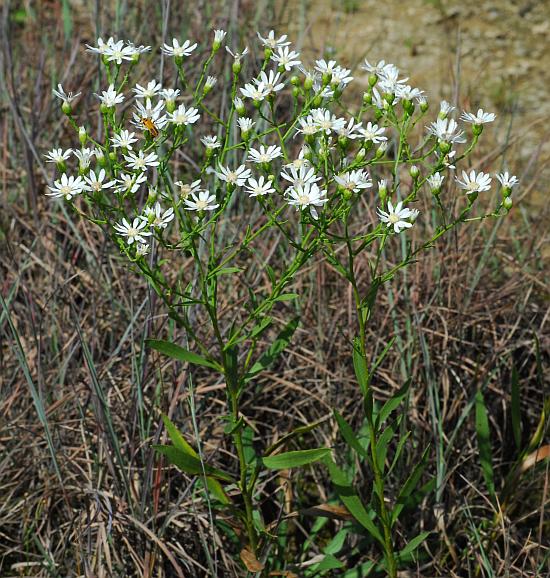Solidago ptarmicoides (Torr. & A. Gray) B. Boivin
White Upland Aster

Native
CC = 9
CW = 5
MOC = 34
© SRTurner
Solidago ptarmicoides (Torr. & A. Gray) B. BoivinWhite Upland Aster | |
 |
Native CC = 9 CW = 5 MOC = 34 |
© SRTurner |
|
Family - Asteraceae/Astereae Habit - Perennial forb with a short, branched rootstock. Stems - Ascending to erect, to 50 cm, sometimes several from the base, branching in the inflorescence, finely longitudinal ridged, moderately roughened with stiff, stout, broad-based, upward-curved hairs toward the tip, sparsely roughened to nearly glabrous toward the base.
Leaves - Alternate, simple, petiolate, basally disposed, offsets often present. Basal and lowermost leaves with the blade 6-20 cm long, 0.5-1.0 cm wide, more than 10 times as long as wide, narrowly oblanceolate to nearly linear, relatively thick and stiff, long-tapered to a sessile or short-petiolate base, angled to a sharply pointed tip, the margins entire or with a few shallow, sharp teeth and minutely roughened, the surfaces often gland-dotted, glabrous or sparsely roughened, the undersurface sometimes moderately hairy, usually with 3 main veins. Median and upper stem leaves 1.5-8.0 cm long, linear to very narrowly elliptic-oblanceolate, the undersurface with 1 main vein or with a faint pair of lateral main veins, otherwise similar to the lower stem leaves. All leaves with a cartilaginous margin approximately 0.1 mm broad, visible with transmitted light.
Inflorescence - Terminal panicles of heads, usually flat-topped, the heads solitary or in small clusters at the branch tips. Peduncles bracteate with reduced leaves, often with some arachnoid pubescence.
Heads - Radiate. Involucre cup-shaped to cylindric, 4-7 mm long, the bracts in 4-6 unequal series. Involucral bracts imbricate, appressed, linear to oblong-lanceolate, all but the outer series rounded to bluntly pointed at the tip, the pale margins slightly irregular to irregularly hairy, the outer surface glabrous, pale yellow to straw-colored at the base, with an oblong to elliptic or somewhat diamond-shaped green area above the base, the midvein usually thickened or keeled, the 1 or 2 pairs of additional veins usually faint. Receptacle naked.
Flowers - Ray florets 10-25, pistillate, the corollas 6-9 mm long, white or less commonly pale cream-colored. Disk about 6 mm in diameter. Disc florets 30-38, the corollas 3.5-4.0 mm long, the 5 lobes 0.5-0.7 mm long, white or less commonly pale cream-colored (sometimes appearing yellow because of the exserted yellow anthers). Pappus 3.5-4.0 mm long, most of the bristles slightly thickened toward the tip.
Fruits - Achenes 1.0-1.5 mm long, narrowly obovoid, glabrous. Flowering - July - September. Habitat - Glades, tops of bluffs, upland prairies, pastures, railroads, and roadsides, often on calcareous substrates. Origin - Native to the U.S. Lookalikes - Certain species of Symphyotrichum, including S. pilosum, S. lateriflorum, S. ontarionis, and S. lanceolatum. Other info. - This small species of Solidago can be found in the southern half of Missouri. The Missouri population is somewhat disjunct from the plant's larger distribution, which is mainly in the north-central U.S. and Canada. The plant is unusual for a goldenrod, in having relatively large heads with white ray flowers. In fact, it is the only Missouri goldenrod having both disk and ray florets white in color. The plant was formerly classified in a different genus and was named Aster ptarmicoides Torr. & A. Gray. Molecular studies indicate a close kinship between this species and the Oligoneuron group within Solidago. Furthermore, the species hybridizes with other goldenrods but not with asters. Photographs taken near Stegal Mountain, Shannon County, MO., 9-12-03 (DETenaglia); also at Taum Sauk State Park, Iron County, MO, 9-19-2012, Glade Top Trail National Scenic Byway, Ozark County, MO, 9-23-2017, and St. Joe State Park, St. Francois County, MO, 9-5-2018 (SRTurner). |